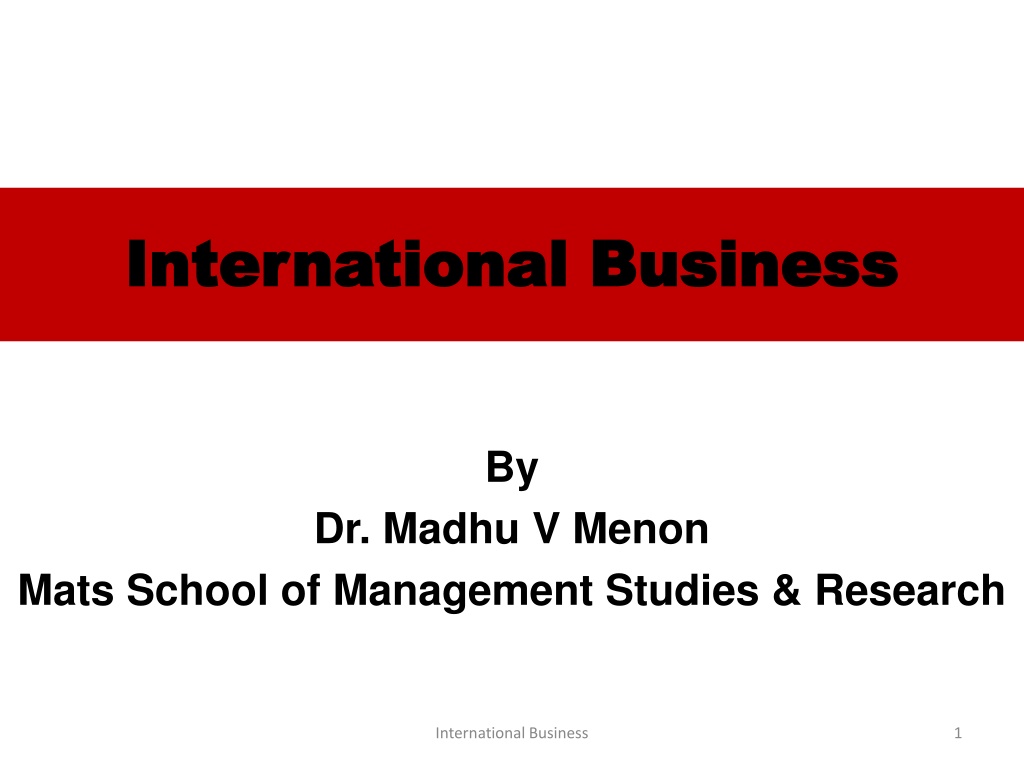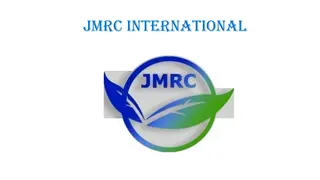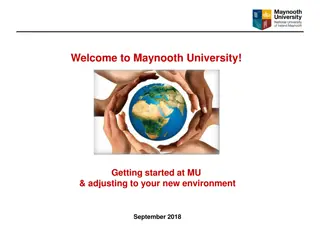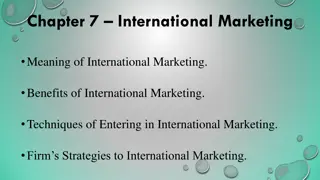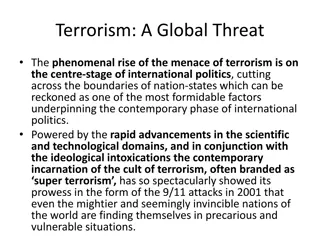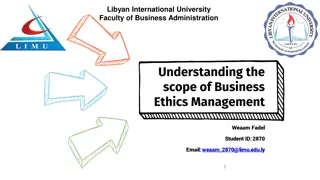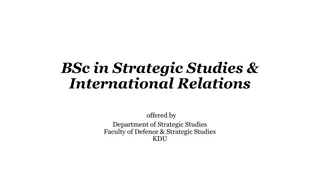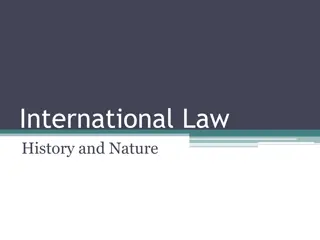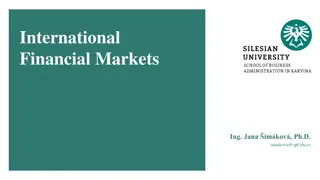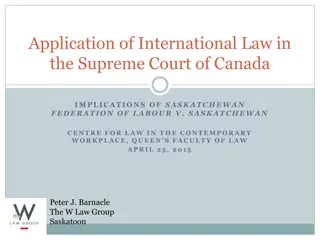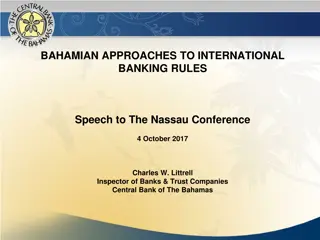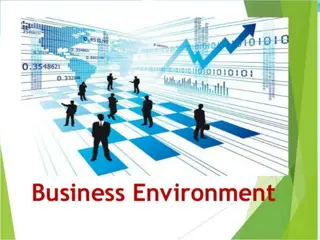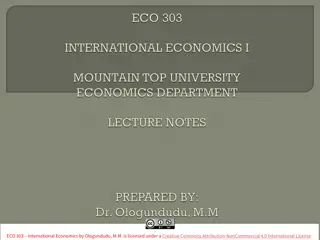Understanding International Business: Overview and Perspectives
International Business involves transactions across national borders to fulfill various objectives. It encompasses activities like exporting goods, licensing production, joint ventures, and more. The concept extends beyond trading goods and services between countries, aiming to cater to international customers and expand market reach by adapting business operations to different countries' needs and preferences.
Download Presentation

Please find below an Image/Link to download the presentation.
The content on the website is provided AS IS for your information and personal use only. It may not be sold, licensed, or shared on other websites without obtaining consent from the author. Download presentation by click this link. If you encounter any issues during the download, it is possible that the publisher has removed the file from their server.
E N D
Presentation Transcript
International Business International Business By Dr. Madhu V Menon Mats School of Management Studies & Research International Business 1
Syllabus MODULE I Introduction Meaning, need for International Business, Evolution of international Business; distinction between international Business and domestic Business, Stages of Globalization- Meaning, Production, Investment Advantages and Disadvantages, MNC s and International Business to International Business: Internationalization, Features, and Technology, Stages- International Business 2
What is International Business International business consists of transactions that are carried out across national borders to satisfy the objectives of individuals, companies, and organizations. International Business transactions all over the world. These transactions include the transfer of goods, services, technology, managerial knowledge, and capital to other countries. conducts business International Business 3
What is International Business An international business has many options for doing business, it includes, 1. Exporting goods and services. 2. Giving license to produce goods in the host country. 3. Starting a joint venture with a company. 4. Opening a branch for producing & distributing goods in the host country. 5. Providing managerial services to companies in the host country. International Business 4
Definition of International Business Cambridge business as: the activity of trading goods and services between countries. However, international business is beyond this definition. International business is a cross- border transaction businesses, or government entities dictionary defines international between individuals, International Business 5
Definition of International Business Some more Definition: 1. The process of extending the business activities from domestic to any foreign country with an intention of targeting international customers. 2. The conduction of business activities by any company across the nations. 3. The expansion of business functions to various countries with an objective of fulfilling the needs and wants of international customers International Business 6
Need of International Business The needs of International Business: 1. Market Expansion. 2. Non- availability of Product. 3. Cost Advantage 4. Economic recession in home market. 5. Low domestic demand. 6. Excess production capacity 7. Greater Purchasing Power International Business 7
Scope of International Business The scope of international businesses are: 1. Importing and Exporting 2. Licensing 3. Franchising 4. Contract Manufacturing/Outsourcing 5. Joint Ventures 6. Foreign Direct Investment 7. Growth Opportunities 8. Integration of Economies International Business 8
Evaluation Of International Business Global trade is as old as human history Every country is not self Sufficient. In olden times, People uses bartered goods & services with each other. One could trace International Trade back in 3000 B.C. The origin of International Business is International Trade. International Business 9
Evaluation Of International Business One of the oldest known trading routes and perhaps the longest and most successful in the history was the Silk Road. The Silk Road was a network of many trading routes that originated in China and ended at the Mediterranean Sea and Europe. Silk road was used between 50 BCE to 250 CE is perhaps the most well-known example of IT. International Business 10
Evaluation Of International Business The 17 Century so Industry Revolution in Europe. International Business 11
Distinction Between International Business Domestic business involves those transactions that take place within the boundaries of a country. The Buyer and seller belong to the same country in DB DB deal with the same currency since both the buyer and seller are from the same country. Domestic Business International business (IB) involves those transactions that take place outside the boundaries of a country. The buyer and seller belong to different countries in IB IB deal with currencies since the buyer and seller are not from the same country. (DB) economic economic geographical geographical different International Business 12
Distinction Between International Business Domestic Business There is greater homogeneity in terms of the nature of customers of DB There is greater heterogeneity in terms of the nature of customers of IB Geographical boundaries limit DB Geographical boundaries do not limit IB Capital investment is lower for companies that are involved in DB Capital investment is higher for companies that are involved in IB The DB has greater mobility of factors of production compared to IB The IB has lesser mobility of factors of production compared to IB International Business 13
Stages in Internationalization Internationalization is the process of increasing involvement of enterprises in international markets. Reach out to the international market more often than not is faced with hitches and challenges one. The optimal strategic attractive available to firms depend upon different internationalization. Most companies view foreign operations as riskier than domestic ones because they must operate in environments which are less familiar to them. levels of International Business 14
Stages in Internationalization Enterprises undertake international activities reluctantly and follow practices to minimize their risks. Stages of internationalization can be followed: 1. Domestic Company. 2. International Company 3. Multinational Company 4. Global Company: 5. Transnational Company: International Business 15
Stages in Internationalization Domestic Company: It limits its operations, mission and vision to the national political boundaries. These companies focus its view on the domestic market opportunities, domestic financial customers etc. These companies environment of the country, formulate the strategies to exploit the opportunities offered by the environment. domestic companies, suppliers, domestic analyze the national International Business 16
Stages in Internationalization International Company: These companies select the strategy of locating the branch in the foreign market and extend the same domestic operations into foreign markets. These companies remain ethnocentric or domestic country oriented. Normally internalization process of most of the global companies starts with this stage of two processes. Many of the companies follow this strategy due to limited resources and also to learn from the foreign market gradually before becoming a global company without much risk. International Business 17
Stages in Internationalization Multinational Company: This stage of multinational company is also referred as multi-domestic company It formulates different strategies for different market thus the orientation shift from ethnocentric to polycentric. Under polycentric orientation the offices/branches/ subsidiaries of a MNC work like a domestic company in each country where they operate with distinct policies and strategies suitable to that country concerned. International Business 18
Stages in Internationalization Global Company: An International Company that centralizes management and other decisions in the home country. It is the one which has either produces in home country or in a single country and focuses on marketing these products globally and focuses on marketing these products domestically. International Business 19
Stages in Internationalization Transnational Company: A commercial enterprise that runs several facilities and conducts business in multiple countries. These company produces, market, invests and operate across the world. It is an integrated global enterprise which links global resources with global market at profits. There is no such pure transnational corporation. International Business 20
Stages in Internationalization Characteristics of a Transnational Company This company thinks globally and acts locally. This company adopts global strategy but allow value addition to the customer of a domestic country. The assets of a transnational company are distributed throughout the world, independent and specialized. The R&D facilities of a transnational company are spread in many countries International Business 21
Globalization The term globalization refers to the integration of the economy of the nation with the world economy. Globalization is the free movement of goods, services and people across the world in a seamless and integrated manner. Globalization can be thought of to be the result of the opening up of the global economy and the concomitant increase in trade between nations. International Business 22
Globalization Production & Investment The barriers on foreign trade and foreign investment were removed to a large extent. This meant that goods could be imported and exported easily and also foreign companies could set up factories and offices here. Removing barriers or restrictions set by the government is what is known as liberalization. With liberalization of trade, businesses are allowed to make decisions freely about what they wish to import or export.. International Business 23
Globalization Factors that have Enabled Globalization Technology Rapid improvement in technology has been one major factor that has stimulated the globalization process. This has made possible much faster delivery of goods across long distances at lower costs. The developments in information and communication technology have made accessible. . information instantly International Business 24
Globalization 1. Transfer of Technology 2. Better Services 3. Standardization of Living 4. Development of Infrastructure 5. Foreign Exchange Reserves 6. Economic Growth 7. Affordable Products 8. Contribution to World GDP Growth Rate 9. Extensions of Market . Advantages of Globalization International Business 25
Globalization Disadvantages of Globalization 1. Growing Inequality: 2. Increasing of the Unemployment rate: 3. Trade Imbalance: 4. Environmental Loots: International Business 26
MNC & International Business A multinational corporation (MNC) has facilities and other assets in at least one country other than its home country. MNC generally has offices and/or factories in different countries and a centralized head office where they coordinate global management. Having a presence in a foreign country such as China allows a corporation to meet Chinese demand for its product without the transaction costs associated with long-distance shipping. International Business 27
MNC & International Business MNC tend to establish operations in markets where their capital is most efficient or wages are lowest. By producing the same quality of goods at lower costs, multinationals reduce prices and increase the purchasing power of consumers worldwide. Establishing operations in many different countries, a multinational is able to take advantage of tax variations. The other benefits include spurring job growth in the local economies, potential increases in the company's tax revenues, and increased variety of goods. International Business 28
MODULE - II MODULE II Theories of International Trade: Classical and Neo-classical theories, Mercantilism, Absolute Cost Advantage theory, Comparative advantage theory, Factor-proportions theory, Product Life Cycle theory. International Business 29
Theories of International Trade International trade theories are simply different theories to explain international trade. Trade is the concept of exchanging goods and services between two people or entities. International trade is then the concept of this exchange between people or entities in two different countries. People or entities trade because they believe that they benefit from the exchange. They may need goods or services. While at the surface, this many sound very simple, there is a great deal of theory, policy, and business strategy that constitutes international trade. or want the International Business 30
Theories of International Trade Classical theories: 1. Mercantilism, 2. Absolute Cost Advantage theory, 3. Comparative advantage theory, 4. Factor-proportions theory Neo-classical theories: 1. Product Life Cycle theory. International Business 31
Theories of International Trade Mercantilism: Developed in the sixteenth century & was one of the earliest efforts to develop an economic theory. This theory stated that a country s wealth was determined by the amount of its gold and silver holdings. In it s simplest sense, mercantilists believed that a country should increase its holdings of gold and silver by promoting exports and discouraging imports. International Business 32
Theories of International Trade The objective of each country was to have a trade surplus or a situation where the value of exports are greater than the value of imports. A closer look at world history from the 1500s to the late 1800s helps explain why this theory flourished. This strategy is called protectionism and is still used today Nations expanded their wealth by using their colonies around the world in an effort to control more trade and amass more riches. International Business 33
Theories of International Trade Although mercantilism is one of the oldest trade theories, it remains part of modern thinking. Countries such as Japan, China, Singapore, Taiwan, and even Germany still favor exports and discourage imports Mercantilism s protectionist policies only benefit select industries, at the expense of both consumers and other companies, within and outside of the industry International Business 34
Theories of International Trade Absolute Advantage: In 1776, Adam Smith questioned the leading mercantile theory Smith offered a new trade theory called absolute advantage, which focused on the ability of a country to produce a goods more efficiently than another nation. Smith reasoned that trade between countries shouldn t be regulated or restricted by government policy or intervention. International Business 35
Theories of International Trade By efficiencies, because their labor force would become more skilled by doing the same tasks. Therefore, production would also become more efficient. Smith s theory reasoned that with increased efficiencies This theory stated that a nation s wealth shouldn t be judged by how much gold and silver it had but rather by the living standards of its people. specialization, countries would generate International Business 36
Theories of International Trade Comparative Advantage: The challenge to the absolute advantage theory was that some countries may be better at producing both goods and, therefore, have an advantage in many areas. In contrast, another country may not have any useful absolute advantages. To answer this challenge, David Ricardo, an English economist, introduced the theory of comparative advantage in 1817. International Business 37
Theories of International Trade Ricardo reasoned that even if Country A had the absolute advantage in the production of both products, specialization and trade could still occur between two countries. Comparative advantage occurs when a country cannot produce a product more efficiently than the other country; However, it can produce that product better and more efficiently than it does other goods. International Business 38
Theories of International Trade However, it can produce that product better and more efficiently than it does other goods. The difference between these two theories is subtle. Comparative advantage focuses on the relative productivity differences, advantage looks at the absolute productivity. whereas absolute International Business 39
Theories of International Trade Case Study Let s look at a simplified hypothetical example to illustrate the subtle difference between these principles. Miranda is a Wall Street lawyer who charges $500 per hour for her legal services. It turns out that Miranda can also type faster than the administrative assistants in her office, who are paid $40 per hour. Even though Miranda clearly has the absolute advantage in both kill sets, should she do both jobs? No. For every hour Miranda decides to type instead of do legal work, she would be giving up International Business 40
Theories of International Trade $460 in income. Her productivity and income will be highest if she specializes in the higher-paid legal services and hires the most qualified administrative assistant, who can type fast, although a little slower than Miranda. By having both Miranda and her assistant concentrate on their respective tasks, their overall productivity as a team is higher. This is comparative advantage. A person or a country will specialize in doing what they do relatively better. International Business 41
Theories of International Trade In reality, the world economy is more complex and consists of more than two countries and products. Barriers to trade may exist, and goods must be transported, stored, and distributed. However, this simplistic example demonstrates the basis of the comparative advantage theory. International Business 42
Theories of International Trade Heckscher-Ohlin Theory or Factor Proportions Theory The theories of Smith and Ricardo didn t help countries determine which products would give a country an advantage. Both theories assumed that free and open markets would lead countries and producers to determine which goods they could produce more efficiently. In the early 1900s, two Swedish economists, Eli Heckscher & Bertil Ohlin, focused their attention on how a country could gain comparative advantage by International Business 43
Theories of International Trade producing products that utilized factors that were in abundance in the country. Their theory is based on a country s production factors land, labor, and capital, which provide the funds for investment in plants and equipment. They determined that the cost of any factor or resource was a function of supply and demand. Factors that were in great supply relative to demand would be cheaper; factors in great demand relative to supply would be more expensive. International Business 44
Theories of International Trade Their theory, also called the factor proportions theory, stated that countries would produce and export goods that required resources or factors that were in great supply and, therefore, cheaper production factors. In contrast, countries would import goods that required resources that were in short supply, but higher demand. For example, China and India are home to cheap, large pools of labor. Hence these countries have become the optimal locations for labor-intensive industries International Business 45
Theories of International Trade Their theory, also called the factor proportions theory, stated that countries would produce and export goods that required resources or factors that were in great supply and, therefore, cheaper production factors. In contrast, countries would import goods that required resources that were in short supply, but higher demand. For example, China and India are home to cheap, large pools of labor. Hence these countries have become the optimal locations for labor-intensive industries International Business 46
Theories of International Trade Neo Classical Theory Product Life Cycle Theory: Raymond Vernon, US Management Guru, developed this theory in the 1960s. The theory, originating in the field of marketing, stated that a product life cycle has three distinct stages: 1. New product, 2. Maturing product, and 3. Standardized product. International Business 47
Theories of International Trade The theory assumed that production of the new product will occur completely in the home country of its innovation. It has also been used to describe how the personal computer (PC) went through its product cycle. The product life cycle theory has been less able to explain current trade patterns where innovation and manufacturing occur around the world. For example, global companies even conduct research and development in developing markets where highly skilled labor and facilities are usually cheaper. International Business 48
Theories of International Trade Even though research and development is typically associated with the first or new product stage and therefore completed in the home country, these developing or emerging-market countries, such as India and China, offer both highly skilled labor and new research facilities at a substantial cost advantage for global firms. International Business 49
Syllabus MODULE III Modes of Entry in International Business: Mode of Entry: Exporting, Licensing, Franchising, Contract Manufacturing, Turn Key Projects, Foreign Direct Investment Mergers, Acquisitions and Joint Ventures, Comparison of different modes of Entry. International Business 50
